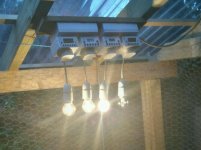I have bought some p.o.l. pullets recently as my main flock are into their autumnal decline in laying and I want to maintain some egg production over the winter months. I have bought a low wattage lamp and a timer and am planning to install this as soon as I get chance, my plan is to gradually increase the light time until they have around 16 hours of light a day. I haven't bought a dimmer as I want to keep it as simple as I can, I am planning to put the light on during the night and let them roost naturally in the evening.
My main question here though is; I have a pophole on the henhouse that usually stays open, when the light comes on and it is dark outside will they stay in the hut in the light or would they assume it was daytime and go outside and stand in the dark ? If they were to go and stand outside obviously I shall be defeating my objective.
I would appreciate any advice given by you professionals out there ! Thank you.
My main question here though is; I have a pophole on the henhouse that usually stays open, when the light comes on and it is dark outside will they stay in the hut in the light or would they assume it was daytime and go outside and stand in the dark ? If they were to go and stand outside obviously I shall be defeating my objective.
I would appreciate any advice given by you professionals out there ! Thank you.

